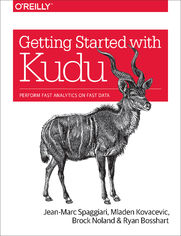Getting Started with Kudu. Perform Fast Analytics on Fast Data - Helion

ISBN: 978-14-919-8020-0
stron: 156, Format: ebook
Data wydania: 2018-07-09
Ksi─Ögarnia: Helion
Cena ksi─ů┼╝ki: 29,90 z┼é (poprzednio: 166,11 z┼é)
Oszczędzasz: 82% (-136,21 zł)
Fast data ingestion, serving, and analytics in the Hadoop ecosystem have forced developers and architects to choose solutions using the least common denominator—either fast analytics at the cost of slow data ingestion or fast data ingestion at the cost of slow analytics. There is an answer to this problem. With the Apache Kudu column-oriented data store, you can easily perform fast analytics on fast data. This practical guide shows you how.
Begun as an internal project at Cloudera, Kudu is an open source solution compatible with many data processing frameworks in the Hadoop environment. In this book, current and former solutions professionals from Cloudera provide use cases, examples, best practices, and sample code to help you get up to speed with Kudu.
- Explore Kudu’s high-level design, including how it spreads data across servers
- Fully administer a Kudu cluster, enable security, and add or remove nodes
- Learn Kudu’s client-side APIs, including how to integrate Apache Impala, Spark, and other frameworks for data manipulation
- Examine Kudu’s schema design, including basic concepts and primitives necessary to make your project successful
- Explore case studies for using Kudu for real-time IoT analytics, predictive modeling, and in combination with another storage engine
Osoby które kupowały "Getting Started with Kudu. Perform Fast Analytics on Fast Data", wybierały także:
- Fundamentals of Metadata Management. Uncover the Meta Grid and Unlock IT, Data, Information, and Knowledge Management 249,17 zł, (29,90 zł -88%)
- Semantic Modeling for Data 249,17 zł, (29,90 zł -88%)
- Power BI Desktop. Kurs video. Wykorzystanie narzędzia w analizie i wizualizacji danych 332,50 zł, (39,90 zł -88%)
- The Practitioner's Guide to Graph Data. Applying Graph Thinking and Graph Technologies to Solve Complex Problems 230,00 zł, (29,90 zł -87%)
- R Cookbook. Proven Recipes for Data Analysis, Statistics, and Graphics. 2nd Edition 230,00 zł, (29,90 zł -87%)
Spis tre┼Ťci
Getting Started with Kudu. Perform Fast Analytics on Fast Data eBook -- spis tre┼Ťci
- Preface
- Conventions Used in This Book
- Using Code Examples
- OReilly Safari
- How to Contact Us
- Acknowledgments
- 1. Why Kudu?
- Why Does Kudu Matter?
- Simplicity Drives Adoption
- New Use Cases
- IoT
- Current Approaches to Real-Time Analytics
- Iteration 1: Hadoop Distributed File System
- Iteration 2: HDFS + Compactions
- Iteration 3: HBase + HDFS
- Real-Time Processing
- Hardware Landscape
- Kudus Unique Place in the Big Data Ecosystem
- Comparing Kudu with Other Ecosystem Components
- Big DataHDFS, HBase, Cassandra
- Conclusion
- 2. About Kudu
- Kudu High-Level Design
- Kudu Roles
- Master Server
- Tablet Server
- Storage
- Columnar format
- File layout and compactions
- Storage
- Kudu Concepts and Mechanisms
- Hotspotting
- Partitioning
- Range partitioning
- Hash partitioning
- Kudu High-Level Design
- 3. Getting Up and Running
- Installation
- Apache Kudu Quickstart VM
- Using Cloudera Manager
- Building from Source
- Packages
- Cloudera Quickstart VM
- Quick Install: Three Minutes or Less
- Conclusion
- Installation
- 4. Kudu Administration
- Planning for Kudu
- Master and Tablet Servers
- Write-Ahead Log
- Data Servers and Storage
- Replication Strategies
- Deployment Considerations: New or Existing Clusters?
- New Kudu-Only Cluster
- New Hadoop Cluster with Kudu
- Add Kudu to Existing Hadoop Cluster
- Web UI of Tablet and Master Servers
- Master Server UI and Tablet Server UI
- Master Server UI
- Tablet Server UI
- The Kudu Command-Line Interface
- Cluster
- Filesystem
- check
- format
- dump
- Tablet Replica
- Copy a remote replica to a local server
- Deleting a replica
- Consensus Metadata
- Adding and Removing Tablet Servers
- Adding Tablet Servers
- Removing a Tablet Server
- Security
- A Simple Analogy
- Kudu Security Features
- Encryption over the wire
- Data-at-rest encryption
- Kerberos authentication
- User authorization
- Log redaction
- Web UI security
- Basic Performance Tuning
- Kudu Memory Limits
- Maintenance Manager Threads
- Monitoring Performance
- Getting Ahead and Staying Out of Trouble
- Avoid Running Out of Disk Space
- Disk Failures Tolerance
- Backup
- Conclusion
- Planning for Kudu
- 5. Common Developer Tasks for Kudu
- Client API
- Kudu Client
- Kudu Table
- Kudu DDL
- Kudu Scanner Read Modes
- C++ API
- Python API
- Preparing the Python Development Environment
- Python Kudu Application
- Java
- Java Application
- Spark
- Impala with Kudu
- Client API
- 6. Table and Schema Design
- Schema Design Basics
- Schema for Hybrid Transactional/Analytical Processing
- Lambda Architecture
- OLTP/OLAP Split
- Primary Key and Column Design
- Other Column Schema Considerations
- Partitioning Basics
- Range Partitioning
- Hash Partitioning
- Schema Alteration
- Best Practices and Tips
- Partitioning
- Large Objects
- decimal
- Unique Strings
- Compression
- Object Names
- Number of Columns
- Binary Types
- Network Packet Example
- Conclusion
- 7. Kudu Use Cases
- Real-Time Internet of Things Analytics
- Predictive Modeling
- Mixed Platforms Solution
- Index





